Before you get to the article…
On February 23, 2018, my book on the Mau Maus and Sand Street Angels, who were two Brooklyn youth gangs from the 1950s, has been completed. It took 15 years of research and writing to complete Brooklyn Rumble: Mau Maus, Sand Street Angels, and the End of an Era. This book is roughly 6″x9″ and has 370 pages and includes a look at the characters in the Mau Maus and the details of a gang killing that happened in February 1959 in front of the iconic Brooklyn Paramount Theater (now Long Island University). If you want to buy a copy, click here and this link will take you to an online ordering page.
——-
New York City suffered from a gang epidemic for close to 20 years, but by the early 1960s, youth gangs were quickly becoming a thing of the past. What was the cause of their demise? While gang intervention played a role, the rise of drugs like heroin had a huge impact. If a gang member were to get hooked on smack, their focus shifted from their friends in the gang and protecting their turf, to getting their next fix.
Many gang members fell into the trap of drug addiction and once-proud jitterbuggers were wasting away to the ravages of heroin. One such example was Rafael Alvarez who lived in East Harlem. In the mid 1950s he was a member of the Latin Aces and the Dragons, both fighting gangs who were well-known to the police. But by the early 1960s, he had succumbed to a life of drug-use and was arrested for drug possession at his home at 35 East 110th Street on February 8, 1963. See the report below for details on the arrest along with the quantity of drugs apprehended.
It turns out that not only was Alvarez a user of both cocaine and heroin, but he was a mid-level trafficker of heroin, which probably helped him support his habit. Alvarez had devoted his life to crime beginning when he was young up to the time of his arrest and when confronted with this, his reply was, “it’s just one of them things.” Alvarez probably never intended his life to end up that way, as nobody aspires to be a drug user when growing up. In fact, Rafael remarked to the authorities that it was ironic he was arrested because he “used to hate drugs and junkies and then I find that I was using them myself.” What was the cost of his addiction? The daily cost of Rafael’s habit was $5 to $8 per day. At the time of his arrest, East Harlem was quickly becoming a mecca for drugs with the Lucchese family being a major dealer.
It goes without saying that the drug problem wasn’t only in East Harlem, but all across the city. Details gleaned from a gang member from the Sand Street Angels from the Brooklyn Navy Yard area show that he, too, succumbed to the powerful allure of heroin. In the words of the investigator:
The defendant’s involvement in the instant offense (burglary) came about from his using drugs. The defendant was friendly with a number of youth in the neighborhood who were using drugs. One of these friends, “Rengo,” talked the defendant into becoming “high” sometime in February 1960. The defendant began by mainlining. He felt no after effects at first and subsequently began using heroin on and off. At the time of his arrest, he was using it fairly regularly, about once or twice a day at a cost of $5 to $10 per day… he did add that “most of the fellows in the neighborhood used drugs.”
The jitterbugging gangs of New York City eventually evaporated, never to be seen again. The concept of fighting for turf was destroyed by the insidious advance of heroin which changed the landscape greatly. Although I have not read it, Eric Schneider wrote a book called Smack: Heroin and the American City. Much of it is devoted to the effects of heroin and other drugs on New York City, which was known as the nation’s heroin capital.

